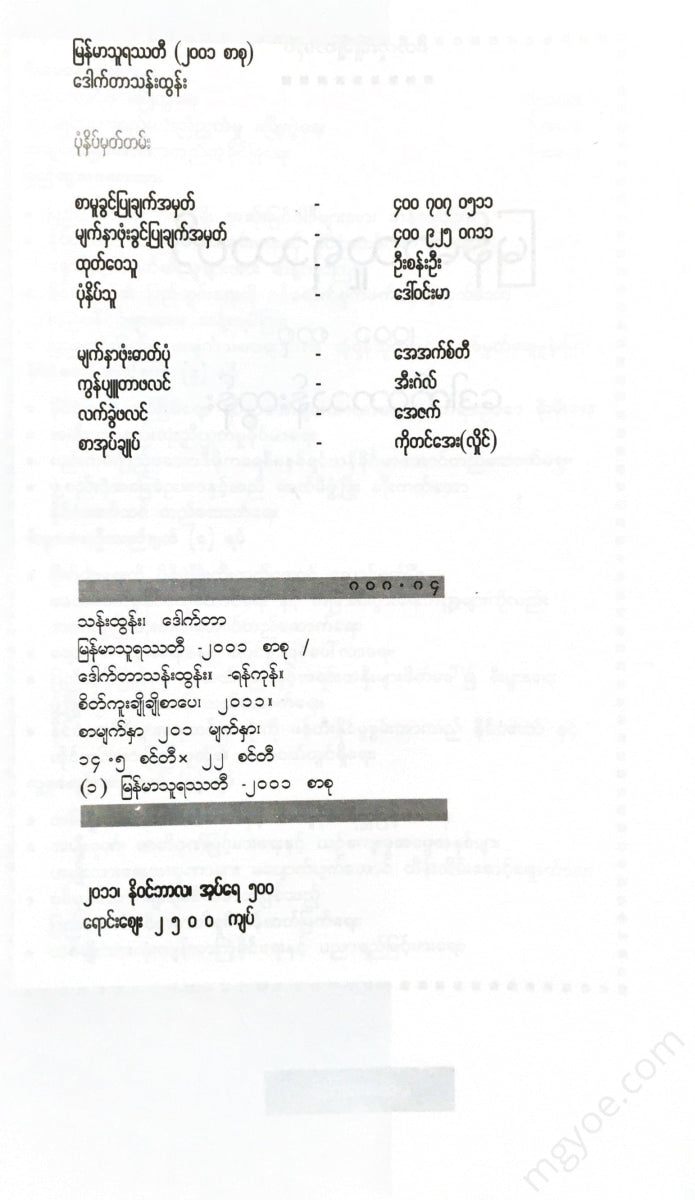စိတ်ကူးချိုချိုစာပေ
Dr. Than Tun - Myanmar Thurasati 2001 Collection
Dr. Than Tun - Myanmar Thurasati 2001 Collection
Couldn't load pickup availability
Higher than the Pāja Paramita. (Gapte. 106, 107 & 108). This development is believed to have begun with the rise of Wayana Buddhism in India in the 7th and 8th centuries. (Gupre, 28)... In Japan, the goddess Saraswati is known to the monks of Van Than (Gupte 109, Grunwedd 105, 148 in)
The beginning of Saraswati worship in Myanmar is found in the Shwe Si Khon Mon inscription, so it is believed to be around 1048 AD. However, there are many references to her in Burmese literature (Toe Hla has found and given an example of her in the Yaturkan Echin). These references date from 1494 to 1942. In this literature, Saraswati is considered a goddess of wisdom and eloquence. The Hindu goddess is described as a goddess who protects Buddhism in the Sixty-eighth Gatha (verse 78), and as a goddess with a palace in a lake in the Linatta (verse 72). In the Hitakari (verse 3), the Nanasandha (verse 106) and the Adhikappa (116), this goddess is described as white. She is described as riding a chariot and holding a lotus in one hand. In the Letwe Nawratha Vaithu (214-15), this goddess is mentioned since the beginning of the world. She is very powerful, and her speech is very good. The person she protects is wise and speaks only valuable words. It is believed that Rama, Samma and Dana, who wrote secular texts, often mention this goddess at the beginning of their books. Even those who wrote the Lokuktatra text say that they want to take the name of this goddess. Why do they do this? Because this goddess is still seen holding the three copies of the Pitaka in her hand. This means that Saraswati protects the religion and protects the Buddha's teachings. I have seen this written by Taungdwin Sayadaw on 31 August 1762. (Letwe Nawratha Vaithu 214-15). In modern times, this form of offering to the goddess is found in the Balinatsa Athayathi (Yangon Sudhammawaddy, 1951, 13, 17, 2930 and 97). It can also be found in the following books and publications.
A document on how to offer the nine offerings to the Sein Pe Buddha, Yangon.
Shwedagon U Poin Publishing House, 1973, 111-12, 121,
122, 123, 125, 127 and 245,
Cave of the Gods: “Gouramanta (aka) Goura Vinda - Burmese God”
2BRS x EIIIi, June 1960 , 51-5
Kyaw (Divbasakkhusara) White House..
Mantra Union, Rangoon, Sudhammawaddy, 1961, 139, 140, 142, 143, 144, 147, 148,
149, 151, 152, 155, 157 and 161
Tin Aung "The Nine Gods" JBRS xxx VII, ii ; Rec 1954,1-9 Po Kha Thirty Seventeen, Rangoon, Myanmar Honor Printing, 1973, 16, 20, 21 and 24.
Thurazz, Volume (1), No. (12),
December, 2001.

























